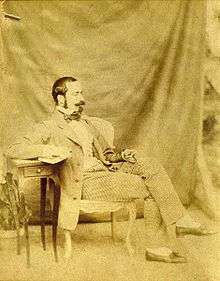Hotel Gaillard
The Hotel Gaillard is a Parisian mansion built between 1878 and 1882 by architect Jules Février on request of banker Emile Gaillard. It is located Place du Général Catroux, in the 17th district of Paris. The hotel hosted in late 2014 the Cité de l'économie et de la monnaie.


The builder
Emile Gaillard was the Parisian representative of a provincial family bank, founded in Grenoble by his grandfather Théodore François Gaillard in the 18th century. His father, Théodore Eugène Gaillard, was the mayor of Grenoble from 1858 to 1865. During his banker career, Emile Gaillard participated in the financing of railway networks, managed the Count of Chambord’s wealth, and was also Victor Hugo’s banker. His artistic sensitivity made him one of Chopin’s best students, who dedicated one of his mazurkas to him.
Emile Gaillard was a collector, amateur of Middle Ages and Renaissance art. Pieces of furniture, decorative art objects, tapestries and works of art constituted his collection. This collection becoming impossible to hold in his accommodation of rue Daru, Emile Gaillard decided to have a mansion built on the Plaine Monceau, in the 17th district of Paris. He asked Jules Février to build this neo-gothic castle for him in 1878.
Emile Gaillard died in 1902. After his death, the family bank was sold to Credit Lyonnais.
The building
The mansion is a pastiche of French Renaissance constructions built in the Loire Valley, which aimed at emphasizing Emile Gaillard’s art collection. Indeed, the architect had visited the Château de Blois and the Château de Gien.[1] The magazine La Semaine des constructeurs wrote in 1882: “Mr. Février has been deeply inspired by the Château de Blois, while he still rethought the details, the plan, the facings and the decorations in a very original and personal way”.
In 1885, Mr. and Mrs. Gaillard hosted a costumed ball in the famous Ball Room, to which more than 2000 guests were invited. Emile Gaillard welcomed his guests dressed in a Henri II of France attire.[2]
After Emile Gaillard’s death, his collection was sold at Hôtel Drouot in 1904.
The purchase by Banque de France
The building remained empty, until the mansion was sold to the Banque de France in 1919 to become one of its branches. The rehabilitation works were made by architect Alphonse Defrasse between 1919 and 1921, and by interior decorator Jansen. It was listed historic monument by a bylaw of April 12, 1999.[3]


The Cité de l'économie et de la monnaie
At the end of 2014, the Banque de France will open a Cité de l'économie et de la monnaie in the building. It will be a place dedicated to the discovery of economic concepts. The winning team that will carry the project is constituted by Ateliers Lion (Yves Lion) for the architecture, François Confino for the museography, and Eric Pallot as specialist of historic monuments.[4]
References
- Historical study on the Hotel Gaillard, led by the Groupe de Recherche Art Histoire Architecture et Littérature (GRAHAL), on Banque de France's request
- Journal des Batignolles, 1885, quoted by Lucien Maillard in Scope Mag, May 2011, p. 16.
- Mérimée.
- Banque de France press release "Un grand projet pour un lieu unique : Cité de l'économie et de la monnaie", May 25th, 2011.
External links
| Wikimedia Commons has media related to Hôtel Gaillard. |